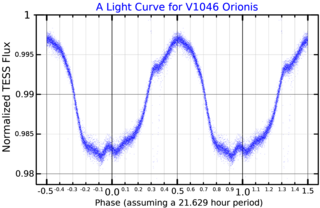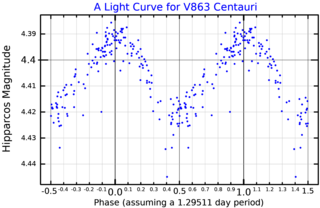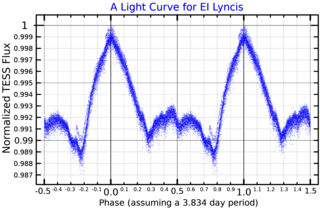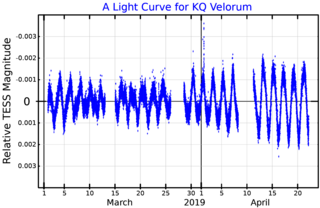In astrophysics, chemically peculiar stars are stars with distinctly unusual metal abundances, at least in their surface layers.

A B-type main-sequence star is a main-sequence (hydrogen-burning) star of spectral type B and luminosity class V. These stars have from 2 to 16 times the mass of the Sun and surface temperatures between 10,000 and 30,000 K. B-type stars are extremely luminous and blue. Their spectra have strong neutral helium absorption lines, which are most prominent at the B2 subclass, and moderately strong hydrogen lines. Examples include Regulus and Algol A.
56 Aquarii, abbreviated 56 Aqr, is a star in the constellation of Aquarius. 56 Aquarii is its Flamsteed designation. It is a sixth magnitude star, having an apparent visual magnitude of 6.36, and thus is a challenge to view with the naked eye. Based upon an annual parallax shift of 5.07 mas, it is located around 643 light years from the Earth. At that distance, the visual magnitude is diminished by an extinction of 0.12 due to interstellar dust. The star is moving closer with a heliocentric radial velocity of −28 km/s. It is a candidate runaway star showing a transverse peculiar velocity of 213.87 km/s.

12 Canis Majoris is a variable star located about 707 light years away from the Sun in the southern constellation of Canis Major. It has the variable star designation HK Canis Majoris; 12 Canis Majoris is the Flamsteed designation. This body is just barely visible to the naked eye as a dim, blue-white hued star with a baseline apparent visual magnitude of +6.07. It is moving away from the Earth with a heliocentric radial velocity of +16 km/s. This is the brightest star in the vicinity of the open cluster NGC 2287, although it is probably not a member based on its proper motion.
21 Canum Venaticorum is a single variable star in the northern constellation of Canes Venatici, located 277 light years away from the Sun. This object has the variable star designation BK Canum Venaticorum; 21 Canum Venaticorum is the Flamsteed designation. It is visible to the naked eye as a faint white-hued star with a baseline apparent visual magnitude of +5.14.

HD 125823, also known as V761 Centauri or a Centauri, is a variable star in the constellation Centaurus. It is a blue-white star that is visible to the naked eye with a mean apparent visual magnitude of +4.41. The distance to this star is approximately 460 light years based on parallax measurements. It is a member of the Upper Centaurus–Lupus subgroup of the Scorpius–Centaurus association.

HD 37017 is a binary star system in the equatorial constellation of Orion. It has the variable star designation V1046 Orionis; HD 37017 is the identifier from the Henry Draper Catalogue. The system is a challenge to view with the naked eye, being close to the lower limit of visibility with a combined apparent visual magnitude of 6.55. It is located at a distance of approximately 1,230 light years based on parallax, and is drifting further away with a radial velocity of +32 km/s. The system is part of star cluster NGC 1981.
HD 35520 is a single star in the northern constellation of Auriga. It has a white hue and is dimly visible to the naked eye with an apparent visual magnitude of 5.92. The distance to this star is approximately 2,200 light years based on parallax. The radial velocity for the star is, as yet, poorly constrained.

BX Boötis is a star in the northern constellation of Boötes. It is a dim star near the lower limit of visibility to the naked eye, having a nominal apparent visual magnitude of 6.35. Based upon an annual parallax shift of 10.81 mas, it is located 302 light years away. At that distance, the visual magnitude of the star is diminished by an extinction of 0.13 due to interstellar dust. It is moving closer with a heliocentric radial velocity of −11 km/s.

HD 105382 is a star in the constellation Centaurus. Its apparent magnitude is 4.47. From parallax measurements, it is located 130 parsecs from the Sun.
4 Cygni is a binary star system in the northern constellation of Cygnus. It is a faintly visible to the naked eye with an apparent visual magnitude of 5.17. The distance to 4 Cygni, as determined from its annual parallax shift of 5.8 mas, is about 560 light years.

HD 137509 is a star in the southern constellation of Apus, positioned less than a degree from the northern constellation boundary with Triangulum Australe. It has the variable star designation of NN Apodis, or NN Aps for short, and ranges in brightness from an apparent visual magnitude of 6.86 down to 6.93 with a period of 4.4916 days. The star is located at a distance of approximately 647 light years from the Sun based on parallax, and is drifting further away with a radial velocity of +0.50 km/s.

36 Lyncis is a solitary variable star located around 620 light years away from the Sun in the northern constellation of Lynx. It has the variable star designation of EI Lyncis, while 36 Lyncis is the Flamsteed designation. This object is visible to the naked eye as a dim, blue-white hued star with an apparent visual magnitude of 5.30. It is moving further away from the Earth with a heliocentric radial velocity of 21 km/s.

HR 273 is a chemically peculiar spectroscopic binary system in the northern circumpolar constellation of Cassiopeia. It has an apparent visual magnitude of 5.9 making it faintly visible to the naked eye from dark suburban skies. Parallax measurements with the Hipparcos spacecraft put this system at a distance of roughly 350 light years.
Theta Hydri, Latinized from θ Hydri, is the Bayer designation for a blue-white hued star in the southern constellation of Hydrus. It is faintly visible to the naked eye with an apparent visual magnitude of +5.53. Based upon an annual parallax shift of 6.50 mas as seen from Earth, is located approximately 502 light years from the Sun. At that distance, the visual magnitude of the star is diminished by an extinction of 0.10 due to interstellar dust. It is moving away from the Sun with a radial velocity of +12.3 km/s.
HD 142250 is a star in the constellation Scorpius. It has a visual apparent magnitude of 6.1, being visible to the naked eye only in excellent seeing conditions. From parallax measurements, it is located 486 light-years (149 parsecs) away from Earth. This distance, together with the star's proper motion, indicate that HIP 77900 is a member of the Upper Scorpius subgroup of the Scorpius–Centaurus association, the nearest OB association to the Sun. This subgroup is the youngest of the three of the association, with an estimated age of 11 million years.

KQ Velorum is a variable star system in the southern constellation of Vela. It has the identifier HD 94660 in the Henry Draper Catalogue; KQ Vel is the variable star designation. This appears as a sixth magnitude star with an apparent visual magnitude of 6.112, and thus is dimly visible to the naked eye under suitable viewing conditions. The system is located at a distance of approximately 373 light years from the Sun based on parallax measurements, and is drifting further away with a radial velocity of around 23 km/s.
HD 196775 is a solitary star in the equatorial constellation Delphinus. It has an apparent magnitude of 5.98, allowing it to be faintly seen with the naked eye. The object is relatively far at a distance of 1,050 light years but is approaching the Solar System with a heliocentric radial velocity of −4.6 km/s. HD 196775 has a high peculiar velocity of 21.8+1.9
−4.1 km/s compared to neighboring stars, indicating that it may be a runaway star.

HD 31134, also designated as HR 1561, is a solitary star located in the northern circumpolar constellation Camelopardalis, the giraffe. It is faintly visible to the naked eye as a white-hued star with an apparent magnitude of 5.74. Gaia DR3 parallax measurements place it 473 light years away. It appears to be approaching the Solar System with a heliocentric radial velocity of −15.1 km/s. At its current distance, HD 31134's brightness is diminished by 0.35 magnitudes due to interstellar dust. It has an absolute magnitude of +0.19.

HD 28843, also known as HR 1441 and DZ Eridani, is a star about 550 light years from the Earth, in the constellation Eridanus. It is a 5th magnitude star, so it will be faintly visible to the naked eye of an observer far from city lights. It is a variable star, whose brightness varies slightly from 5.70 to 5.84 during its 1.374 day rotation period. It is a member of the μ Tauri Association, a group of young stars within the larger Cassiopeia-Taurus Structure.











